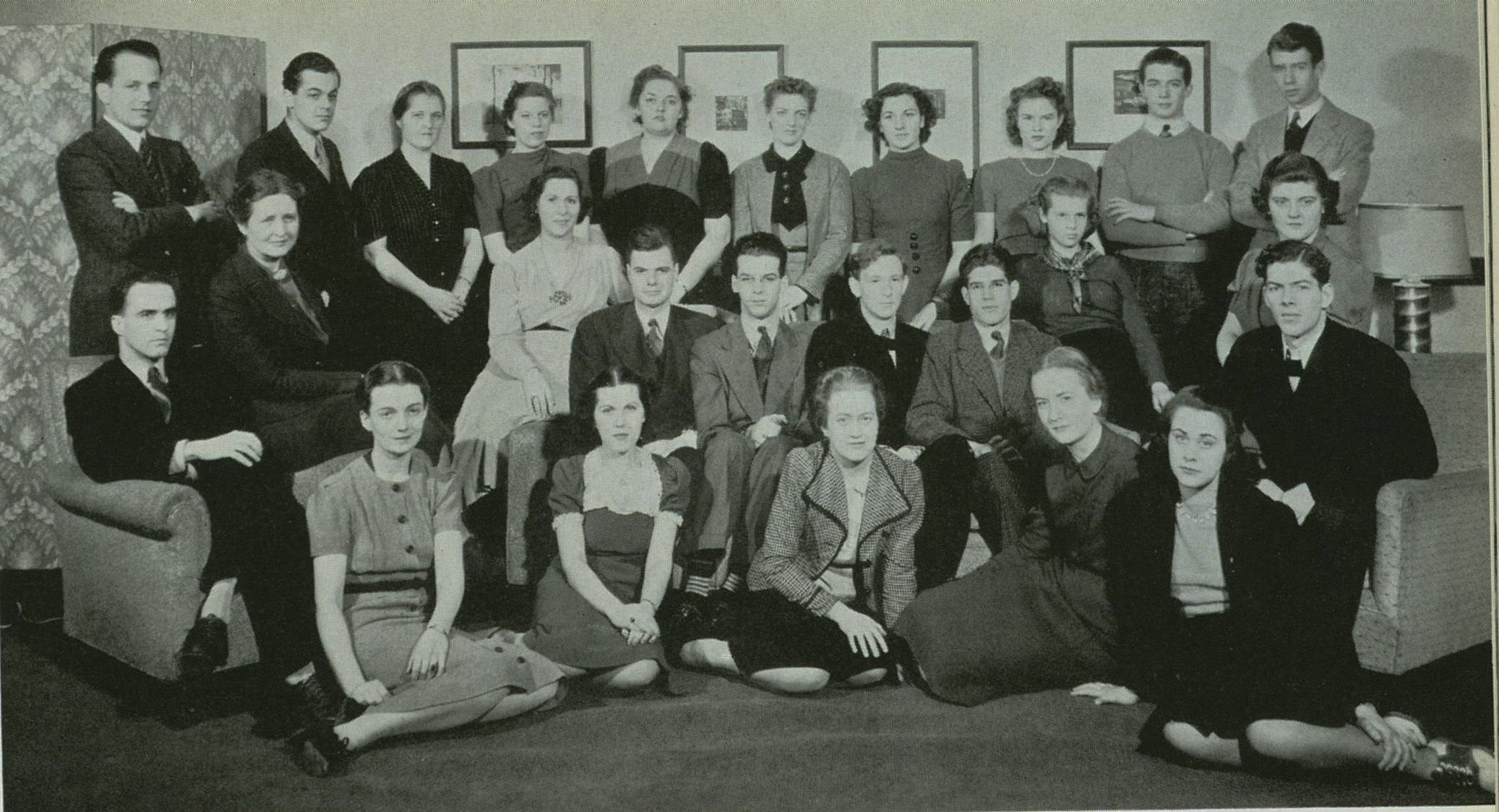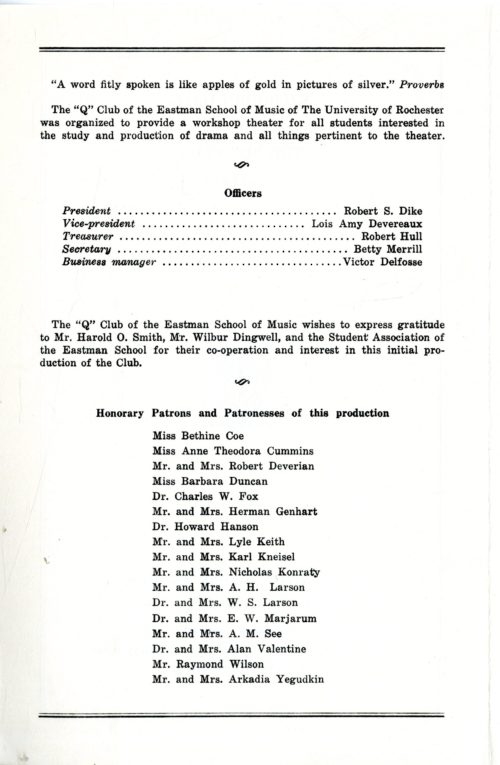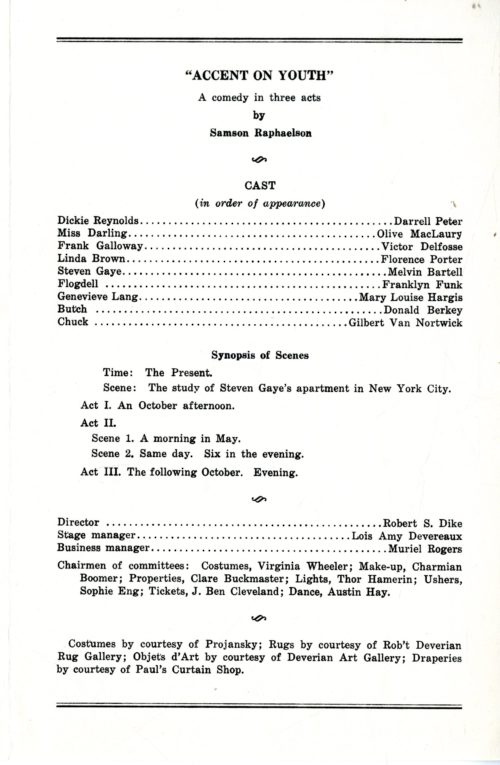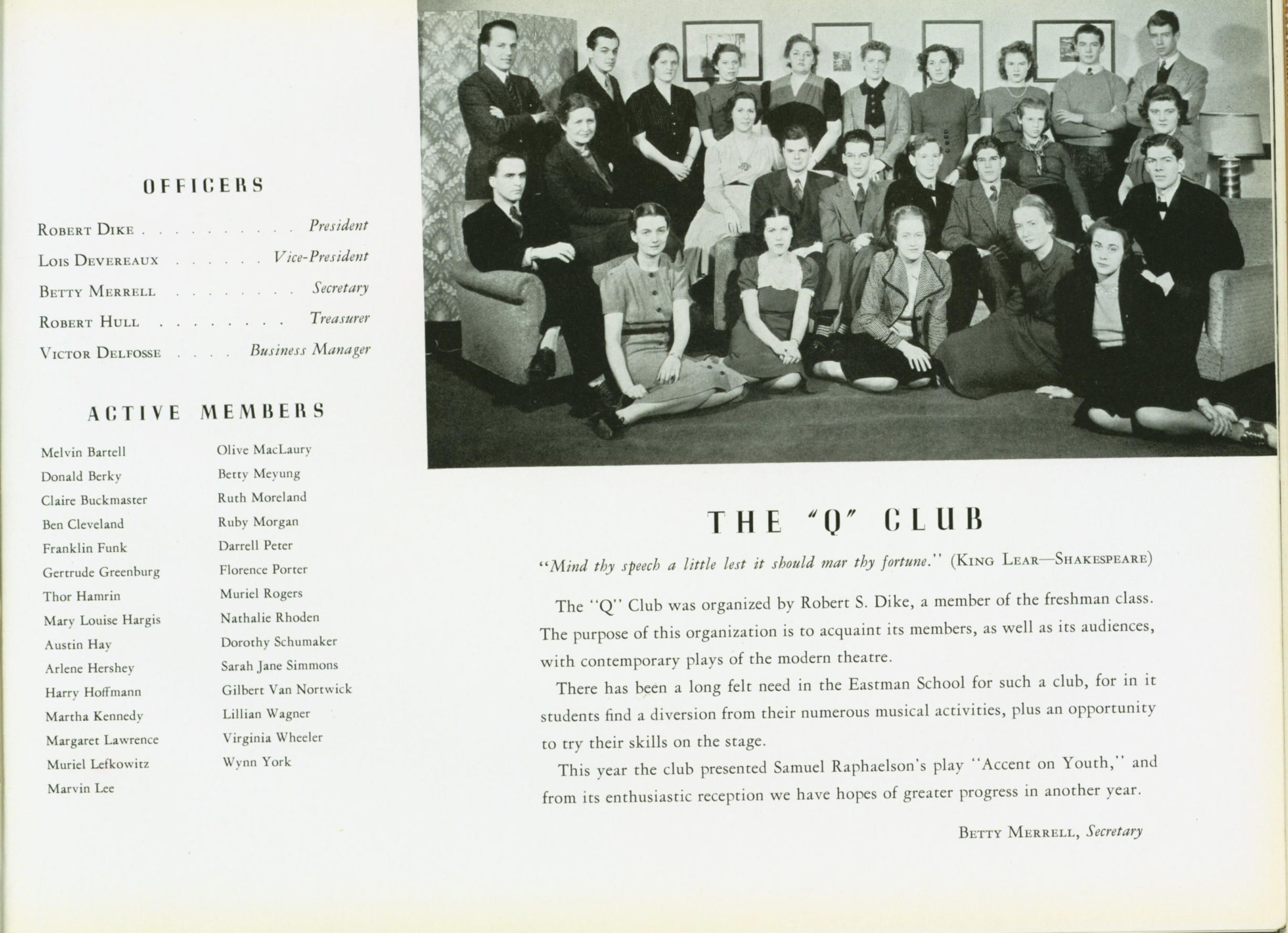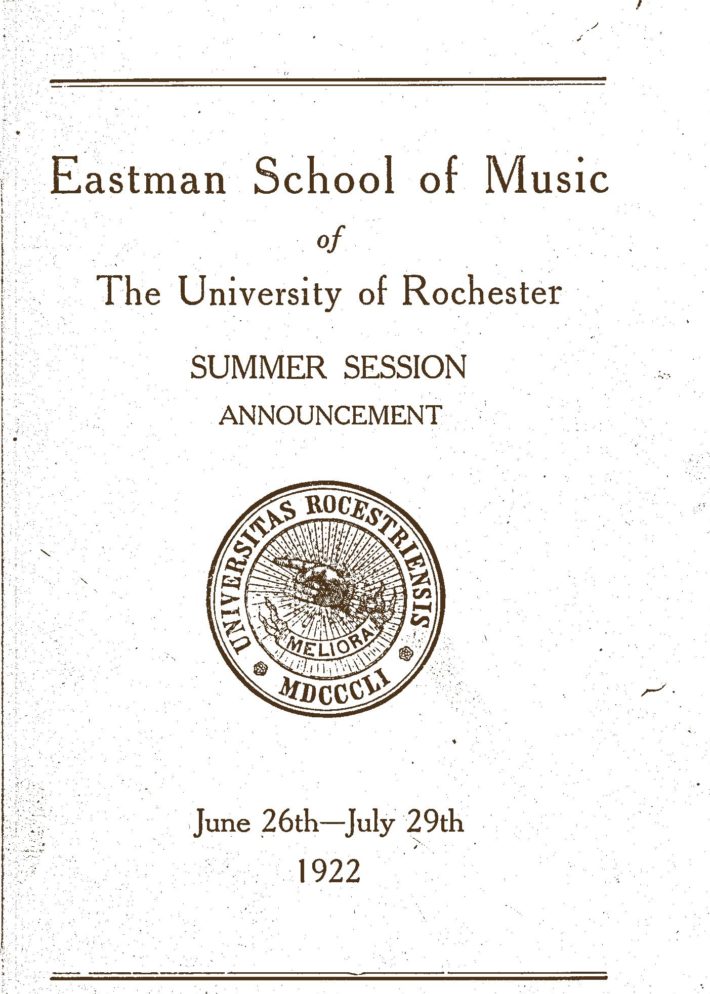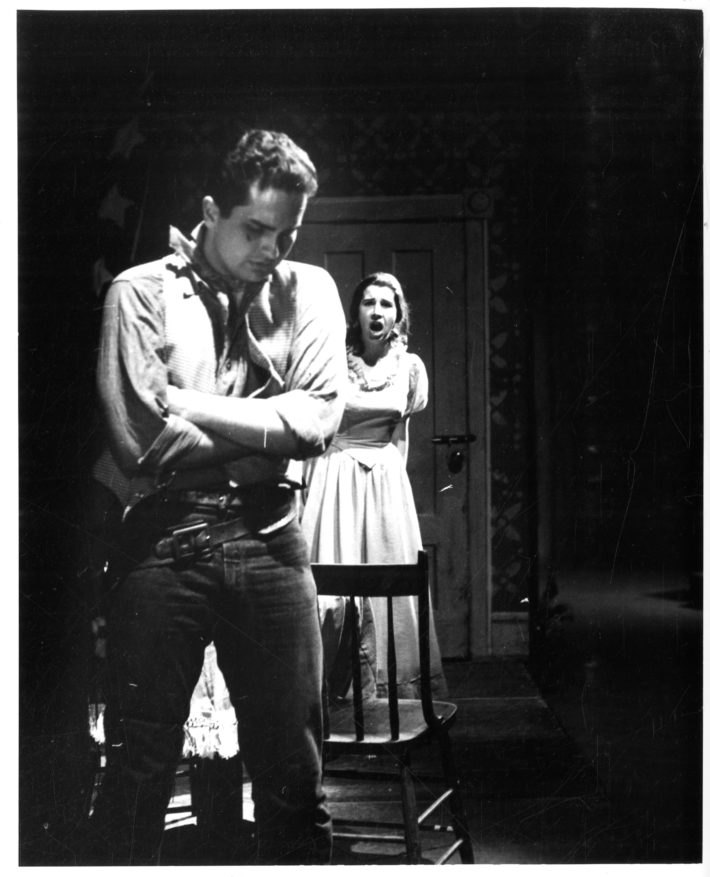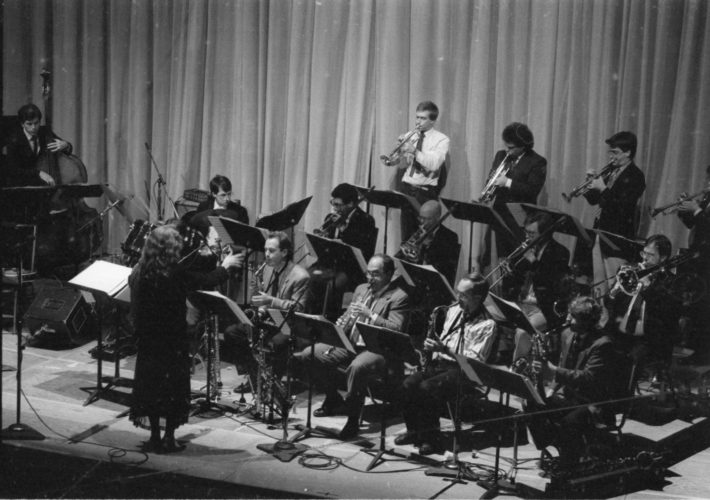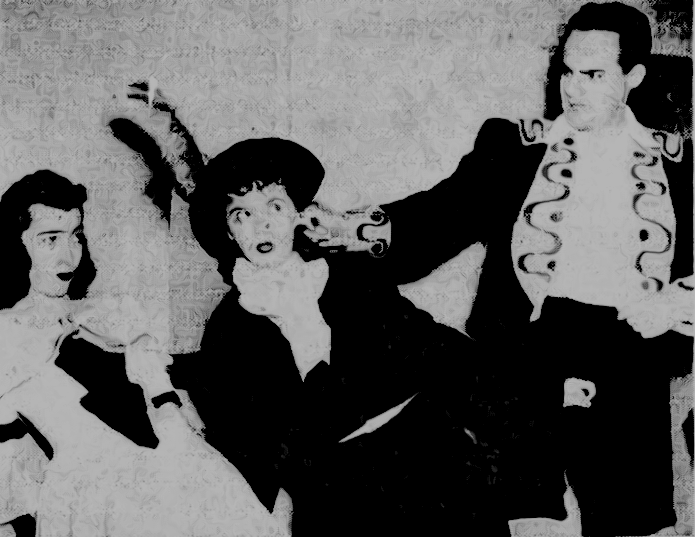March 27th- April 2nd:The “Q” Club makes its dramatic debut in Kilbourn Hall
March 27, 20231939: The “Q” Club makes its dramatic debut in Kilbourn Hall
Eighty-four years ago this week, on the evening of Saturday, April 1st, 1939, a select group of Eastman students became Thespians when their newly founded club staged Samson Raphaelson’s play Accent on Youth in Kilbourn Hall. The production was the work of the “Q” Club, which had been founded at Eastman as an opportunity to stage contemporary plays and to learn about the theater. The club was initially organized by freshman Robert Dike (BM ‘42), who served as the club’s president in its first year. In selecting the play Accent on Youth, the “Q” Club had reached directly into the day’s current repertory; the play had premiered long before in 1934, going from its Broadway success to success in London’s West End, where no less an actress than leading lady Greer Garson had played the lead. Accent on Youth had immediately been made into a motion picture in 1935. The play’s author, Samson Raphaelson (1894-1983), was enjoying a highly successful career as playwright and screenwriter; he had scored a major hit in 1927 when his play The Jazz Singer (1925) had become the basis for the first-ever sound motion picture (the first talkie, that is). [1]
The “Q” Club was a part of Eastman School life for four academic years (1938-39 through 1941-42). Altogether, the club’s members produced the following works, each one staged in Kilbourn Hall for one performance:
1938-39:
Accent on Youth by Samson Raphaelson (April 1, 1939)
1939-40:
Another Language by Rose Franken (December 16, 1939)
The Guardsman by Frank Molnar (March 16, 1940)
1940-41:
The Dover Road by A. A. Milne (May 10, 1941)
1941-42:
The Night of January 16th by Ayn Rand (May 9, 1942)
Each of these five plays was described by its respective author as a comedy in three acts.[2] It should be noted that each was in the repertory at that very time, having recently enjoyed a run on Broadway, and three of them also in the West End. The plays of A. A. Milne (1882-1956) had been enjoying success on Broadway and in the West End since the early 1920s; by the time of the “Q” Club in 1941, Mr. Milne was also known for his children’s books featuring that loveable bear Winnie the Pooh, which had been published in the 1920s. Hungarian-born Ferenc Molnár (1878-1952) was a playwright, poet, director, and World War I correspondent who by this time was regarded at home as Hungary’s foremost playwright. Mr. Molnár would spend his final years (1940-52) in the USA, where he enjoyed a certain critical and popular success.[3] His play The Guardsman (1910) had served as the basis for a 1931 motion picture starring Alfred Lunt and Lynn Fontanne, one of Hollywood’s power couples of the screen. Rose Franken (1895-1988) had begun writing as a diversion while caring for her ailing husband; after writing her first play (unproduced), she wrote Hallam Wives (1929) and a short time later reworked as Another Language (1932); in that form the play met with critical and popular success. The “Q” Club’s choice of play in 1942 was by none other than Ayn Rand (pen name for Alice O’Connor; lived 1905-82), best known today for her novels and her much-discussed philosophy,[4] but at that time receiving some attention for the stage plays that she had written in the 1930s. The Night of January 16th (1934) was inspired by the true-life events surrounding the death of Swedish engineer and industrialist Ivar Kreuger (1880-1932). Set in a courtroom during a murder trial, the play has a noteworthy twist in that members of the audience are selected to play the jury.[5]
In keeping with the club’s stated mission “. . .to provide a workshop theater for all students interested in the study and production of drama and all things pertinent to the theater,”[6] members of the “Q” Club managed all aspects of production—not only the actors playing speaking roles on-stage, but also the numerous other responsibilities, including publicity, properties, costumes, and building sets. Each printed program acknowledged individuals who had provided assistance in some capacity; these included the deputy chief of the Rochester Police Department, who was thanked for having provided technical assistance to the production of the The Night of January 16th. “Q” Club members also reached out to local merchants and businesses for material support, duly acknowledging those parties in the printed programs. Advertisements for those same merchants and businesses can be seen in the Eastman School’s yearbooks in various years. Support also came from a number of patrons and patronesses (ah, those good old gender-specific nouns!), who were acknowledged in the printed programs; the roster of patrons in 1939 included the names of some truly illustrious citizens: Director Howard Hanson; Librarian Barbara Duncan; faculty members Dr. Fox (musicologist) and Mr. Konraty (artistic director of Eastman Opera), among others; and University President Dr. Valentine and his wife. Also cited were a young faculty couple, Mr. and Mrs. Karl Kneisel; today the Eastman community celebrates the memory of Jessie Hoskam Kneisel, longtime instructor of German to Eastman students,[7] and also the namesake of a highly respected vocal competition.
For posterity, we have few bases today for knowing the “Q” Club’s full measure of success, alas. The printed program for the April 1st, 1939 production explicitly thanked faculty members H. O. Smith[8] and Wilbur Dingwell[9] and also the Student Association of the Eastman School “. . .for their co-operation and interest in this initial production of the club.” The Student Association’s support was critical, for it endowed the club with a degree of approval, but thereafter, it would remain for the club’s members to make good on that approval by way of outstanding work. At the end of that academic year, The Score 1939 cited the “enthusiastic reception” accorded the club’s first production, which might be taken as one indication (not that the yearbook represented a neutral or disinterested source). The Score 1940, for its part, described the two productions staged in 1939-40 in glowing terms. Leading actor Florence Porter was singled out for mention for having been “hailed by local critics as a ‘discovery’” (one wonders if Ms. Porter ever went on to do any other acting?). The blurb in The Score 1940 continued: “The group was so encouraged by this cordial reception that casting for another play was immediately begun. . .” and further, that second production was described as “an even greater success than their fall production.”[10] One would like to know more, but apart from these laudatory words, no other indication of audience reception or reaction is extant, whether in any Eastman School student newspaper nor in the Rochester press.[11]
Numerous members of the “Q” Club were socially active at school in other ways, and I’d love to spend time tracking all of them. To name just one, Gilbert Van Nortwick, ’42, a future public school music teacher back home in his native Cleveland, was a “Q” Club actor with speaking roles for all of his undergraduate years; he also served as editor-in-chief of The Score 1941 in his junior year, and as president of his senior class in 1941-42. In the wider world beyond Eastman, members of the “Q” Club went on to serve in a range of professional realms, and here I could truly dedicate an entire entry to discussing them. To restrict this to just two, “Q” Club founder Robert S. Dike, ’42 became a mechanical engineer and enjoyed a distinguished career at Los Alamos Scientific Laboratory (Los Alamos, New Mexico).[12] Robert Hull, ’41, another of the club’s 1938-39 charter members, went on to serve as Dean of the College of Fine Arts at the University of Arizona. Sadly, with World War II just around the corner, there would inevitably be casualties and losses. Thor Hamrin, another of the club’s 1938-39 members, did not live to complete his higher education. In November, 1941 he enlisted in the U.S. Army Air Corps and was eventually assigned to the 431st Bomber Squadron; he and his crew died in action off the coast of Truk, the Philippines in July,1944.[13]
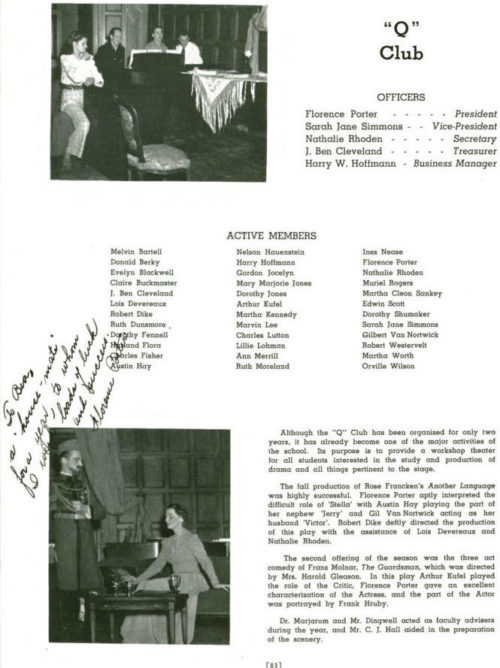
The 1942 production of The Night of January 16th would prove to be the “Q” Club’s valedictory endeavor; there is no record of any further productions. The reasons for the “Q” Club’s cessation are not known, but it isn’t difficult to surmise some of the challenges of the day. The USA’s entry into World War II in December, 1941 wrought many a change throughout all of society; institutions of higher education were obliged to make adjustments to the new circumstances in the coming time.[14] Whatever the reasons may have been, it’s documented that for those four years, the Eastman School of Music had enjoyed an experience of the theater arts owing to the industry and the inquiring, creative minds of its students. To be certain, in the past one hundred years there has been a handful of other, scattered student play productions in Kilbourn Hall, but no effort resembling the serious intention of the “Q” Club. The April 1st, 1939 performance of Accent on Youth amounted to something truly special; Eastman students once again breaking boundaries and doing something new. One more chapter of Eastman history to recall and to celebrate during this week at Eastman.
[1] The career of Samson Raphaelson—author, screenwriter, playwright, and teacher—is noteworthy in several respects. He published short stories, plays, and also a textbook on writing (The Human Nature of Playwriting (1949), which has been re-issued in recent years; the book grew out of his teaching creative writing at the University of Illinois.
[2] Another Language was published as “a comedy drama” and “The Dover Road” was published as “an absurd comedy”. The Night of January 16th was promoted as “a comedy-drama”, the aspect of drama no doubt underscored by the play’s courtroom setting.
[3] Among his numerous credits, his play Liliom (1909), a failure at home in Budapest, met with success abroad and was later the basis for the stage musical Carousel (1945).
[4] Ms. Rand propounded a “new concept of egoism” (her own quotation marks, not mine). The website of the Ayn Rand Institute presents an exposition of Ms. Rand’s thought.
[5] When Kilbourn Hall was dedicated in March, 1922, UR faculty member and de facto poet laureate John R. Slater wrote a beautiful ode under the title “Here Shall Music Have a Home”. Professor Slater’s verse opens with the following lines: “Here shall music have a home. / Here shall many lovers come, / Seeking at her inner shrine / Meanings intimate, divine. / These four walls shall hear the strings / Telling of immortal things.” In the past 101 years, the Kilbourn Hall stage has been the venue of the generous sharing of the art of music, and, incongruously, on one occasion a stage play by a writer whose philosophy precluded any humanitarian impulses.
[6] So stated in the printed program for Accent on Youth, April 1, 1939.
[7] Mrs. Kneisel taught from 1932 until her retirement in 1976. She died in 1992.
[8] Harold Osborn Smith taught English. He served on the Eastman faculty from 1924 until his retirement in 1954.
[9] Mr. Dingwell was an was an instructor of English at the UR; he served from 1936 until 1940. Thanks to my colleague Melissa Mead, University Archivist for this information.
[10] The Score 1940, pages 89 and 92. Accessible online at the UR Libraries Digital Collections site at URL: https://digitalcollections.lib.rochester.edu/ur/score-rochester-ny-1940 .
[11] Music reviewers routinely attended the larger Eastman School productions—that is, ensemble concerts and opera productions—to report on them in the local newspapers, but the SML’s scrapbooks of Rochester press coverage don’t happen to contain any reviews of “Q” Club productions. Further, the only Eastman School student newspaper that is extant today is the run of The Note Book, which was in print 1921-25 and may be read online.
[12] Mr. Dike’s passing in April, 1996 was reported in Rochester Review.
[13] Captain Thor Elmer Hamrin, Jr. is remembered on the Tablet of the Missing in the Manila American Cemetery in Manila, the Philippines. Several websites record his military service, including “Everyday Patriot” site, URL: https://shib2.its.rochester.edu/idp/profile/SAML2/POST/SSO?execution=e1s1 , accessed on March 24, 2023.
[14] Among the wartime changes around the Eastman School, one very obvious example was the transition of the Little Symphony of Phi Mu Alpha from a strictly all-male, fraternity-based ensemble to a co-ed one so as to compensate for the loss of men from the ensemble.

